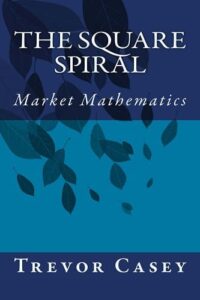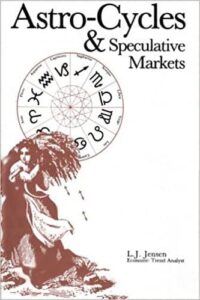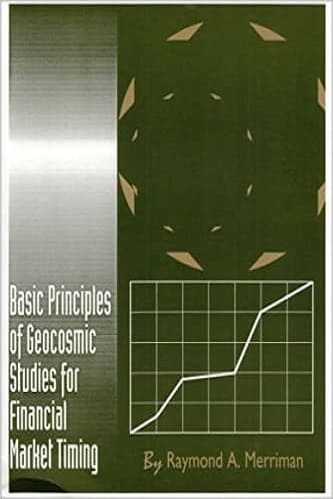Articles
The Genesis of Cycles By William C Garrett
Stock prices move in direct response to only two influences-stock market cycles and the economic outlook-and only indirectly in response to such things as fashion, fundamentals and fiction. This is fortunate ( 1) because economic trends are usually long-range movements and, in any event, are now so thoroughly studied and well-publicized that with a modicum of effort a man can become a passable amateur economist, and ( 2) because cycles in the market beat and repeat with such remarkable regularity that from a study of cycle history . . . “a man may prophesy with a near aim, of the main chance of things as yet not come to life … ”
Cycles in the Stock Market
Cycles in the stock market arise from the rhythmic vibrations of the price of individual stocks as they respond to the daily forces of buying and selling and to the quantity of volume which is generated by these forces. These initial vibrations are recorded daily in your newspaper as the high and low prices reached by each stock, together with the volume generated.
Since these vibrations of price gather force as they accumulate in harmonic waves, the resulting waves of buying and selling become longer and stronger, until, in combination with trend, they dominate market movements. The wave buildup, which comes in surges, derives from anticipation. As more and more stocks rise in price (or a single stock rises higher), the urge-to-buy becomes stronger in a would-be buyer as anticipation of profits grows. As more and more stocks fall in price, the urge-to-sell becomes stronger in a would-be seller, as anticipation of losses grows. As a movement continues, anticipation accelerates with prices and is slowly replaced by hope (or fear).
Since hope is boundless, so is the buildup of cyclical forces into longer and longer cycles. Short cycles in the market reflect the day-to-day balance of buying and selling, and the longer cycles reflect a longer balance and become, in effect, a trend around which shorter price cycles tend to oscillate. The real trend of the market, however, is set by the current economic outlook.
Since the economic climate affects the earnings of most, if not all, companies, it is only natural that the price of a company’s stock is strongly affected by the prospects for the economy. Since the “market” is measured by an average of individual stocks, it is only natural that market-average indexes are affected by the same prospects. The current trend of the nation’s business thus becomes the current trend of the market, and the slant of the trend, whether upward, downward or level, affects the shape of the market rhythms.
Price Cycles Derive From the Tick-Rhythm of Opposed Forces
Price-cycle movements in the market derive from the rhythmic action of two equal but opposed forces as they seek equilibrium. The forces are intangibles: They are ( 1) the desire to buy and ( 2) the desire to sell. They remain intangible at all times because, like gasoline in an automobile tank, only a small portion of the total reaches the engine and is expressed in market transactions. A measure of their relative strengths can be obtained, however, when a decision has crystallized a desire, at which time desire becomes buying volume or selling volume, depending on the direction of the price movement. Since the intangible forces of buying and selling are seldom, in practice, of equal power-if they were. all transactions would be executed at the same price, like canned goods in a grocery-the two forces constantly alternate in dominance.
It is important to remember that the forces are equal in magnitude but opposite in sense or direction. and that one force can become dominant only at the expense of the other, since, at any given moment, there is a finite quantity of would-be buyers and would-be sellers who are close to a decision. The total amount of the two groups changes with volume fluctuations, but at any one time there is always a finite quantity.
Even a small expansion of one force thus must result in compression of the other, and, to regain equilibrium, the second force must react oppositely to the first force. When this occurs, as it constantly does in the market, the confined forces oscillate narrowly across a balance of power, and prices in the market alternate upward and downward in a narrow range, generally with small volume-since only a few buyers and sellers find the price attractive enough to reach a decision and because, when price is alternating narrowly, there is little apparent indication of which direction prices will follow.
This limited alternation of force between the desires is the basic rhythm of the rhythm which we have labelled tick-rhythm. It resembles an idling engine, operating on low volume and with minor force.
Cyclical Impulse Waves Follow a Tick-Rhythm Breakout
When prices are idling in tick-rhythm, it can be expected that shortly one force or the other will become fully dominant. When the breakout comes, the movement of price will crystallize nearby decisions-either by impulse moves of near-would-be buyers or sellers or by predetermined limit orders-and prices will move above or below the tick-rhythm range in a string of transactions, called an impulse wave, in which one force is almost completely dominant. When demand is dominant, prices of a stock will move upward in a series of transactions interspersed by only occasional downticks. When supply is dominant, prices will move downward in a series interspersed by only occasional upticks.
If the price movement is upward, the movement intensifies desire-to-buy and forces a decision on a would-be buyer since price is moving and no longer static or confined to a narrow range. A decision to buy causes additional decisions in other would-be buyers, and theirs, in turn, cause others, so that the upward movement continues in a chain reaction. Another factor which helps to lengthen the impulse waves is that, as prices move upward, the supply of stock being offered at each uptick diminishes at the same time that demand is increasing.
Would-be buyers can only buy stock from pessimistic owners who, as the price rises, become less pessimistic and withdraw their sell orders, since everyone would like a little higher price for his stock. The would-be buyer thus must reach for his stock at higher and higher-and less and less desirable–prices or go without. When prices move downward, the supply of stock being offered at each downtick increases at the same time that demand is diminishing. Would-be sellers can only sell stock to optimistic buyers and, as prices decline, buyers turn less optimistic and more opportunistic and withdraw their buy orders, since no one is adverse to buying lower. The would-be seller thus must sell at lower and lower-and less and less desirable-prices or hold his stock.
Suggested Books and Courses About Cycle Trading and Market Timing
The Square Spiral: The Mathematics of Markets
Original price was: $14.94.$7.47Current price is: $7.47.The Trade Cycle: an Essay
Original price was: $21.17.$10.59Current price is: $10.59.Astro-Cycles and Speculative Markets
Original price was: $51.38.$25.69Current price is: $25.69.Basic Principles of Geocosmic Studies for Financial Market Timing
Original price was: $15.81.$7.91Current price is: $7.91.This carrot-and-stick system of prices causes price to move rapidly in a string of transactions after the first breakout from the tick-rhythm range. So long as demand for a stock continues dominant in the face of ever decreasing supply, the upward movement will continue. So long as supply of a stock continues dominant in the face of ever decreasing demand, the downward movement will continue.
Cyclical Recoil Movements Follow Exhaustion of an Impulse Force
Upward (or downward) impulse movements will continue from a breakout of the tick-rhythm confines to a point where the price of a stock makes it no longer desirable to would-be buyers (or sellers). When this point is reached, the upward impulse force is exhausted and a recoil movement from the impulse wave begins. Typically, this is accompanied by a gradual decrease in the volume of trading.
An upward impulse movement will generally end in a short series of topping-out trades which resembles but is shorter than the tick-rhythm range at the bottom of a movement. The top of the range will form as the highest price is repeated, and a bottom will form at the low end of the short vibrations of tick-rhythm prices. When it is established by a succession of these oscillating trades that price cannot effectively increase above the top of the range, a recoil will start. Prices will drop rapidly after the bottom of the range breaks, just as, in an impulse movement, prices move rapidly from the top of a range. Selling forces will remain dominant until price reaches a point at which selling no longer is attractive to would-be sellers.
The amount of recoil from an upward impulse movement is a vital measurement, since it is largely determined by the amount of selling which accompanies the downturn. If the movement is short, as it usually is in an upward trend, the probability is that buying will soon re-establish itself as the dominant force and prices will continue upward from the recoil. If the movement is deep, however. it is indicative of one of two things: either the trend of prices has turned downward or (2) there has heen no basic trend during the upward movement.
When an economic-or long cyclical-trend is upward, the force of this trend generally will keep prices from recoiling excessively from the upward cyclical impulse movement. For instance, if the power of an upward cycle movement increased from zero to two, as the impulse wave developed, and trend had an upward power of two, it would be probable that the recoil movement would stop in the neighborhood of the two-power value of trend. If trend is flat. or in the process of turning from upward to downward, trend would have no value and the cycle would recoil to the zero from which it originated. The recoil movement of a cycle. as it adjusts to the change from an upward pressure to a downward pressure, is as important as. and on occasion more important than, the impulse movement. since. in effect. it indicates the power and type of the underlying trend.




